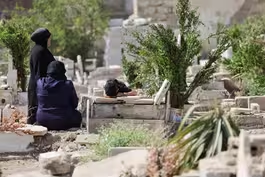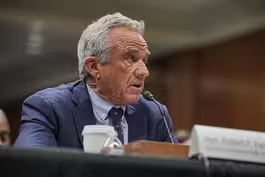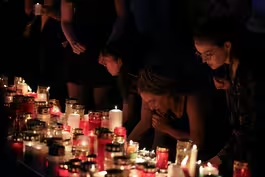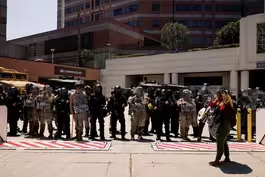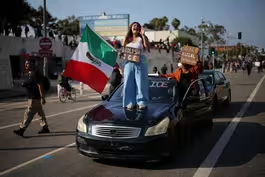
The costly journey Indian migrants face to reach the U.S.
Clip: 6/10/2025 | 9m 23sVideo has Closed Captions
The risky and costly journey Indian migrants face to reach the U.S.
India is one of the largest sources of immigrants to the U.S. with nearly 150,000 arriving each year. While the majority of Indians arrive legally, an estimated 200,000 are now believed to be improperly documented. Many come from relatively affluent regions of India, including the state of Punjab, where several hundred deportees were returned on U.S. military aircraft. Fred de Sam Lazaro reports.
Problems playing video? | Closed Captioning Feedback
Problems playing video? | Closed Captioning Feedback
Major corporate funding for the PBS News Hour is provided by BDO, BNSF, Consumer Cellular, American Cruise Lines, and Raymond James. Funding for the PBS NewsHour Weekend is provided by...

The costly journey Indian migrants face to reach the U.S.
Clip: 6/10/2025 | 9m 23sVideo has Closed Captions
India is one of the largest sources of immigrants to the U.S. with nearly 150,000 arriving each year. While the majority of Indians arrive legally, an estimated 200,000 are now believed to be improperly documented. Many come from relatively affluent regions of India, including the state of Punjab, where several hundred deportees were returned on U.S. military aircraft. Fred de Sam Lazaro reports.
Problems playing video? | Closed Captioning Feedback
How to Watch PBS News Hour
PBS News Hour is available to stream on pbs.org and the free PBS App, available on iPhone, Apple TV, Android TV, Android smartphones, Amazon Fire TV, Amazon Fire Tablet, Roku, Samsung Smart TV, and Vizio.
Providing Support for PBS.org
Learn Moreabout PBS online sponsorshipAMNA NAWAZ: India is one of the largest sources of immigrants to the United States, with nearly 150,000 people arriving each year.
While the vast majority of Indians arrive in the U.S. legally, an estimated 200,000 who are undocumented are now believed to be in the U.S.
Many come from relatively affluent regions of India, including the state of Punjab, where earlier this year several hundred deportees were returned on U.S. military aircraft.
From Punjab, Fred de Sam Lazaro filed this report.
FRED DE SAM LAZARO: Agriculture is the bread and butter of Punjab's economy, sustaining generations of farmers.
But across the landscape of wheat fields are billboards promising a different kind of abundance, life in Australia, the U.K., Canada, or, for many, the big prize, the USA.
And for families who have made it, it's shouted from the rooftop, literally in this case, with a tall replica Statue of Liberty.
With translator Gurpreet Singh (ph), I popped in on Shamsher Singh's home.
SHAMSHER SINGH, Resident of India (through translator): America, the name is so big here.
FRED DE SAM LAZARO: He has a brother who has lived in America for 13 years, he told us.
SHAMSHER SINGH (through translator): Whenever we need something, if we want to buy some land, we ask for his help, and he helps us.
America is royalty.
And if our name is attached to the royalty that is Gods blessing.
DONALD TRUMP, President of the United States: Our nation is blessed to be home to millions of hardworking citizens of Indian and Southeast Asian heritage.
FRED DE SAM LAZARO: For a half-century, legal immigration from Punjab and across India has grown steadily, especially since the 1990s.
The Hindu Festival of Lights, Deepavali, has been celebrated at the White House.
They've come from India's elite,doctors, scholars, and engineers, especially in the tech industry, entrepreneurs in hospitality and trucking, among other businesses.
MUZAFFAR CHISHTI, Senior Fellow, Migration Policy Institute: Overall, Indian migrants in the United States are now the second largest group of foreign-born people in the United States, after Mexicans, which is quite stunning.
FRED DE SAM LAZARO: Muzaffar Chishti is a senior fellow at the Migration Policy Institute at New York University Law School.
MUZAFFAR CHISHTI: About 81 percent have at least a college degree.
About 49 percent of Indian migrants in the United States have at least a master's degree, master's or doctorate.
So it's the highly educated, highly prosperous.
FRED DE SAM LAZARO: And in the push-pull dynamic of migration, he says, the success of Indians abroad is a huge pull factor.
RAVINDER SINGH PANNU, Founder, Sur Sagar TV: It is embedded from your childhood.
FRED DE SAM LAZARO: Ravinder Pannu made it big in Canada as a telecom entrepreneur.
He now spends winters in a palatial home in his ancestral village surrounded by homes built with money earned abroad.
RAVINDER SINGH PANNU: That house where -- do you see the Indian flag?
FRED DE SAM LAZARO: Yes.
RAVINDER SINGH PANNU: They live in America.
You name it, everywhere, you see that, that house, they live in Canada and America.
FRED DE SAM LAZARO: Pannu was born here, but his family has gone back and forth to North America, beginning with his grandfather, who emigrated to the West Coast in the early 1900s.
When people see a grand house like yours and your success, do you think that a lot of people say, I can be like him?
RAVINDER SINGH PANNU: But they don't think it took 40 years of my life to have a comfortable life here in India or in Canada.
So they don't see that.
FRED DE SAM LAZARO: They just see your fancy house.
RAVINDER SINGH PANNU: Exactly.
FRED DE SAM LAZARO: It's part of what fuels a thriving industry of irregular migration by people with marginal education and prospects in a country that, despite substantial economic growth, produces far fewer jobs than job seekers.
Many migrants have reached their destination, slipping in, overstaying tourist visas or, especially in recent years, filing claims for asylum from persecution back home.
MUZAFFAR CHISHTI: And once you apply for asylum, you have to be given the hearing.
And that hearing takes years now to be scheduled.
And during that time, you can -- you live in the U.S. lawfully and you're authorized to work lawfully.
That creates a magnet.
FRED DE SAM LAZARO: The Biden administration began to restrict the asylum option in 2024, deporting thousands after their claims were rejected.
But Chishti says the second Trump administration closed the asylum option completely and very visibly, shackled men perp-walked onto military aircraft, including this one that arrived in Punjab last February.
In general, people migrating from India with improper documents come from the lower middle class.
They are bombarded by advertising all around them and social media with images of a glamorous lifestyle abroad.
Many will borrow mortgage-size sums of money to pursue their dreams.
JITENDER SINGH, Deported Migrant (through translator): We gave 50 million rupees.
FRED DE SAM LAZARO: Thirty-three-year-old Jitender Singh's family sold land and jewelry to raise nearly $60,000 for an agent who promised him passage to the U.S.
He's hoped to find work in the trucking business, which employs some 150,000 members of the Sikh community, whose hallmark turbans stem from a belief system that forbids cutting one's hair.
Jitender made it no further than the border post in San Diego, where he was arrested, frisked, and, weeks later, sent home on that military aircraft.
JITENDER SINGH (through translator): I had to throw my turban in the dustbin.
There was nothing to comb my hair.
All the days we lived there, we lived in bad conditions.
We were handcuffed.
Our feet were chained for 40 hours of the flight.
RAJINDER KAUR, Mother of Deportee (through translator): We have only this home, this home which we built.
FRED DE SAM LAZARO: Jitender's mother, Rajinder Kaur, fears they will likely lose it to pay off their debt, victims of a thriving fraudulent travel business.
SONU SINGH, Social Worker Activist (through translator): They have offices everywhere.
They cheat people.
Then they send them abroad.
And they mislead the young people and show them dreams.
FRED DE SAM LAZARO: Sonu Singh is a local politician and social activist whom we accompanied as he visited a different victim family.
Daler Singh, disabled and unable to work and his wife, Nirmal, borrowed about $55,000 to send their only son, 22-year-old Harpreet, to America.
Instead of the straightforward journey he was promised, he hopscotched from Italy to Spain and across Central America, sleeping in the jungle, extorted at every stop.
HARPREET SINGH, Deported Migrant (through translator): When we reached Guatemala, they took our passports away.
Then they took our phones away.
Then they asked for more money from us.
Then, day by day, they decreased our food.
FRED DE SAM LAZARO: Six months after leaving India, he crossed into San Diego from Tijuana and in short order found himself on a much shorter journey home, deported on the February military plane to a bankrupted family.
DALER SINGH, Father of Deportee (through translator): We thought in, one year, we could return the money.
Now every day I get calls for money.
What will I respond?
SONU SINGH (through translator): I will go to the High Court.
I will get justice from the High Court.
We will try to help get people's money refunded, people suffering from fraud.
FRED DE SAM LAZARO: He's filed dozens of cases so far, but it's a long shot in a justice system that moves slowly at best.
And, in a cruel irony, victims are reluctant to seek recourse against or refunds from traffickers.
NIRMAL SINGH, Mother of Deportee (through translator): The agent told us: "For the same money, I will send your son again if you don't file a case against me."
MUZAFFAR CHISHTI: This is a supply chain of corrupt practices.
FRED DE SAM LAZARO: And New York University's Muzaffar Chishti says taking on the Whac-A-Mole global trafficking business is no easy task.
MUZAFFAR CHISHTI: There's not a big don sitting in California controlling this whole network.
So you can crack down what's happening to the chain of supply in India, but you may not be able to do that in the Darien Gap.
Some person just gets you for one part of the journey to the next, and then to the next, and someone gets you a visa.
FRED DE SAM LAZARO: For now, deportee Jitender's family say they can only pray in thanks for his safe return and hope amid so much uncertainty for the future.
With few job prospects here and the persistent distorted images of glamour abroad, many experts say it will take time to see whether, how, or how deeply the Trump administration's message is resonating across the plains of Punjab.
For the "PBS News Hour," I'm Fred de Sam Lazaro near Amritsar, India.
AMNA NAWAZ: Fred's reporting is a partnership with the Under-Told Stories Project at the University of St. Thomas in Minnesota.
Daughter of American on the search for his remains in Syria
Video has Closed Captions
Clip: 6/10/2025 | 6m 10s | Daughter of American killed in Syria describes the fight to find his remains (6m 10s)
Ex-CDC director reacts to firing of vaccine advisory panel
Video has Closed Captions
Clip: 6/10/2025 | 7m 23s | Former CDC director reacts to RFK Jr.'s firing of entire vaccine advisory panel (7m 23s)
News Wrap: Gunman kills 10 at school in Austria
Video has Closed Captions
Clip: 6/10/2025 | 5m 45s | News Wrap: Gunman kills 10 at school in Austria (5m 45s)
Retired military leaders analyze deployment in LA
Video has Closed Captions
Clip: 6/10/2025 | 8m 20s | Retired military leaders analyze Trump's deployment of Marines and National Guard in LA (8m 20s)
Smithsonian board rejects Trump's attempt to fire top leader
Video has Closed Captions
Clip: 6/10/2025 | 6m 45s | Smithsonian board rejects Trump's attempt to fire top leader (6m 45s)
Troops deployed in LA as immigration raids stir protests
Video has Closed Captions
Clip: 6/10/2025 | 8m 41s | Troops deployed in LA as immigration raids stir fear and protests (8m 41s)
Providing Support for PBS.org
Learn Moreabout PBS online sponsorshipSupport for PBS provided by:
Major corporate funding for the PBS News Hour is provided by BDO, BNSF, Consumer Cellular, American Cruise Lines, and Raymond James. Funding for the PBS NewsHour Weekend is provided by...
